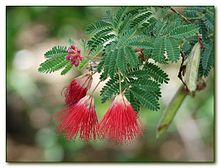Calliandra californica
| Calliandra californica | |
|---|---|

| |
| Scientific classification | |
| Kingdom: | Plantae |
| Clade: | Tracheophytes |
| Clade: | Angiosperms |
| Clade: | Eudicots |
| Clade: | Rosids |
| Order: | Fabales |
| Family: | Fabaceae |
| Subfamily: | Caesalpinioideae |
| Clade: | Mimosoid clade |
| Genus: | Calliandra |
| Species: | C. californica
|
| Binomial name | |
| Calliandra californica | |
| Synonyms[1] | |
| |
Calliandra californica, the Baja fairy duster, is an evergreen, woody shrub, native to Baja California, Mexico. In Spanish, the plant is also known vernacularly as tabardillo, zapotillo[2] or chuparosa.[3] The flowers, which appear in early summer, have clusters of red stamens. The shrub is usually 0.6–1.8 metres (2 ft 0 in – 5 ft 11 in) in height and has bipinnate leaves. The leaves have been described as "fern-like."[4] Leaves close at night time.[5]
Calliandra californica is cold tolerant to temperatures of 22 °F (−6 °C),[5] though its roots will tolerate temperatures as low as 5 °F (−15 °C).[6] It grows best in full sun.[5] C. californica is very drought tolerant, needing only 10 inches (250 mm) of water every year.[6] However, additional watering will encourage C. californica to bloom through summer and again in the fall.[6]
Propagation of C. californica is done through "acid scarification" or vegetative cutting.[5] Seed pods from this plant look like "snow peas" and when ripe, they explode.[4] The pods are flat and about 2 inches (51 mm) long.[6] After ejecting seeds, the curled open pods remain attached to the plant for some time.[7]
Calliandra californica attracts both bees and hummingbirds.[5]
Along with many other legumes and leadworts (Plumbago),[8] it is a host plant for the Marine Blue caterpillar (Leptotes marina).[9]
In landscaping, it is suggested that C. californica is used in borders or foreground plantings, as an island accent or even in containers.[6]



References
- ^ The Plant List: A Working List of All Plant Species, retrieved 19 June 2016
- ^ "Calliandra californica". Germplasm Resources Information Network. Agricultural Research Service, United States Department of Agriculture. Retrieved 7 May 2015.
- ^ "Calliandra californica". ILDIS. Legume Web. 1 November 2005. Retrieved 7 May 2015.
- ^ a b Meyer, Chris; Meyer, Trish. "Calliandra californica: Baja Fairy Duster". Wildscaping. Sherman Oaks Garden. Retrieved 4 May 2015.
- ^ a b c d e "Calliandra californica". Arizona State University. Retrieved 4 May 2015.
- ^ ISBN 9781616739492.
- ^ "Baja Fairy Duster". Department of Forest Resources and Environmental Conservation. Virginia Tech. Retrieved 4 May 2015.
- ^ "Marine Blue". Butterflies and Moths of North America. Archived from the original on 2007-11-17.
- ^ Rich Bailowitz and Jim Brock. "Southeastern Arizona" (PDF). North American Butterfly Association.
Further reading
 Media related to Calliandra californica at Wikimedia Commons
Media related to Calliandra californica at Wikimedia Commons
